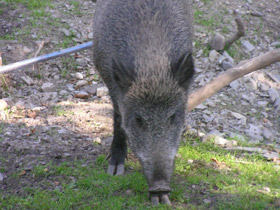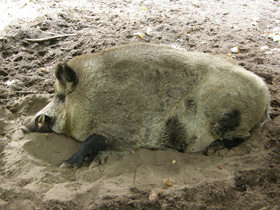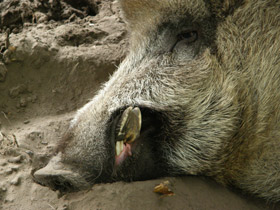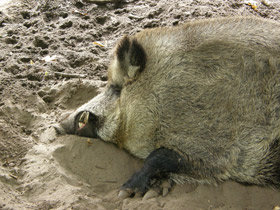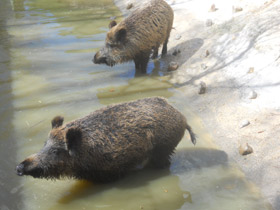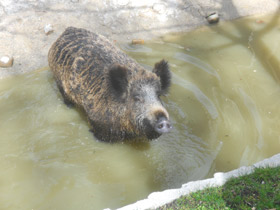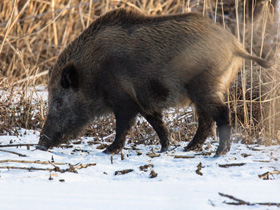Wild boar Sus scrofa
The wild boar or Eurasian wild pig is a large animal, with body length ranging from 130 to 175 cm, height reaching 1 meter, and weight, 60 to 150 kg (some wild boar males may weigh up to 275 kg). The wild boar differs from domestic pigs by its laterally flattened body, thick brownish-grey coarse bristles forming a crest along the backbone, large tusks in males, and black nasal disc. The wild boar is widely distributed on all continents excepting Antarctica, and on many oceanic islands. Over-hunting and changes in land use have resulted in the fragmentation of its range and its extermination throughout the British Isles, Scandinavia, parts of North Africa, and relatively extensive parts of its range in the former Soviet Union, and northern Japan. Particularly large animas weighing as much as 300 kg are still encountered in the Russian Far East. In the recent years the wild boar’s range in European part of the Russian Federation largely expanded to the northwest, to South Karelia and Kama river basin. The Eurasian wild pigs usually occur in grasslands and reed jungles, and mixed and deciduous forests, but they can live in a variety of habitats, from dark coniferous to tropical forests. They could be found in steppes and mountains at higher elevations. In Europe, the wild boars prefer broadleaved forests and especially beech and oak forests alternating with wetlands, grasslands, and open fields, where food is abundant. Wild boars live in small groups, with only old males and females with their offspring staying separately from the group. In some periods, when food is scarce, groups of wild boars can migrate long distances, covering hundreds kilometres. Wild boars tend to stay inactive in the day, lying in the shade of the forests or reed bed thickets. Preparing the lying place, wild boar will dig the snow to reach the soil trying to lie down on the layer of branches, moss, and dry grass. The wild boar can easily flare its hooves, which helps it to move through the low cover of snow and soft squashy ground, but to move in the deep snow, this pig has to make a furrow with its chest or move in small leaps because short legs in these animals prevent their movement through deep snow. The snow depth of 30 to 40 cm may make a fatal effect, as well as ice crust that may severely injure their legs. Deep penetration of frost line into the soil in cold winters makes food unavailable for the wild boars, and they have to live on their body fat, with many of them dying of inanition. Due to its short legs, body shape, and great physical strength, the wild boar can at a high speed make its way through the deadfalls, dense bush, and impenetrable thickets of lianas and reeds. These pigs are omnivorous, feeding on rhizomes and bulbs of various plants, fallen fruit, nuts, acorns, worms, and insects, but they can occasionally eat other small animals, including young rodents, snakes, frogs, birds and their eggs. When a herd of wild boars finds a carrion, it will stay close to it for mane days, tearing meat from the bones. The wild boars usually forage digging the soil and forest litter with their tusks and hard nasal discs. Their presence in the forest could be easily revealed by large areas of ploughed ground. In winters they often forage in marshes, where frost doesn’t penetrate into soil.
Tusker-males fight violently in breeding season, but a layer of thick tissue under the skin on their necks and shoulders protects them from serious injuries. Gestation in sows lasts 4 to 4.5 months and results in the birth of four to six piglets (sometimes there are 12 offspring in the litter). Prior to giving birth, the sow builds a cozy mound-like nest, with soft substrate and canopy of grass and branches, and during the fist week of life little wild boars lie in the nest, huddling together. Some time later, they start accompanying their mother during foraging. Striped coloration of the piglets fades by the age of three months, and weaning take place in autumn. The females start breeding in the second year of life, and the males, in the fourth or fifth year. The wild boars play an essential role in functioning of forest ecosystems. By disturbing large areas of the soil, they create better conditions for the germination of various seedlings, and restoration of tree species. Besides, these animals eradicate many forest pests, such as the bordered white.


















